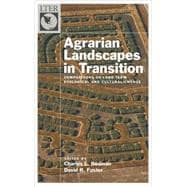
Note: Supplemental materials are not guaranteed with Rental or Used book purchases.
Purchase Benefits
What is included with this book?
| About the Contributors | p. ix |
| Introduction | p. 3 |
| Changing Agrarian Landscapes across America: A Comparative Perspective | p. 16 |
| New England's Forest Landscape: Ecological Legacies and Conservation Patterns Shaped by Agrarian History | p. 44 |
| Agricultural Transformation of Southern Appalachia | p. 89 |
| Dustbowl Legacies: Long-Term Change and Resilience in the Shortgrass Steppe | p. 122 |
| The Political Ecology of Southwest Michigan Agriculture, 1837-2000 | p. 152 |
| Agrarian Landscape Transition in the Flint Hills of Kansas: Legacies and Resilience | p. 206 |
| Water Can Flow Uphill: A Narrative of Central Arizona | p. 238 |
| Conclusion | p. 272 |
| Index | p. 279 |
| Table of Contents provided by Ingram. All Rights Reserved. |
The New copy of this book will include any supplemental materials advertised. Please check the title of the book to determine if it should include any access cards, study guides, lab manuals, CDs, etc.
The Used, Rental and eBook copies of this book are not guaranteed to include any supplemental materials. Typically, only the book itself is included. This is true even if the title states it includes any access cards, study guides, lab manuals, CDs, etc.